National Green Hydrogen Mission

- 19 Oct 2024
In News:
- The Union Government has sanctioned three pilot projects under the National Green Hydrogen Mission to explore the use of green hydrogen in steel production.
- The initiative aims to demonstrate safe and efficient hydrogen-based steelmaking processes, validate their technical feasibility, and evaluate economic viability for low-carbon steel production.
- Objectives of the Scheme:
- Identify and test advanced technologies for utilizing green hydrogen in the steel sector.
- Demonstrate safe and secure operation of hydrogen-based steel production.
- Validate technical and economic feasibility, contributing to decarbonization of iron and steel manufacturing.
- Pilot Project Components:
-
- 100% Hydrogen-based Direct Reduced Iron (DRI) using vertical shaft furnaces.
- Hydrogen use in Blast Furnace to reduce coal/coke consumption.
- Hydrogen injection in vertical shaft-based DRI units.
-
- Sanctioned Pilot Projects:
- Matrix Gas and Renewables Ltd
- Capacity: 50 tons per day (TPD).
- Consortium Partners: Gensol Engineering Ltd, IIT Bhubaneswar, Metsol AB (Sweden).
- Simplex Castings Ltd
- Capacity: 40 TPD.
- Consortium Partners: BSBK Pvt. Ltd., Ten Eight Investment, IIT Bhilai.
- Steel Authority of India Ltd (SAIL)
- Capacity: 3,200 TPD (Ranchi).
- Financial Support:
- Total Government Funding: ?347 crore for the three projects.
- These pilot projects are expected to be commissioned within the next three years and may serve as a blueprint for scaling up such technologies in India.
- About the National Green Hydrogen Mission:
- Launched: January 4, 2023.
- Total Budget: ?19,744 crore (up to FY 2029-30).
- Primary Goal: Establish India as a global hub for green hydrogen production and export while fostering decarbonization in sectors like steel, mobility, and energy.
- Key Features of the Mission:
- SIGHT (Strategic Interventions for Green Hydrogen Transition):
- Supports domestic manufacturing of electrolysers and promotes the production and use of green hydrogen.
- Expected Outcomes by 2030:
- Green Hydrogen Production: At least 5 million metric tons (MMT) annually.
- Renewable Energy: Addition of 125 GW in renewable energy capacity.
- Investment: Over ?8 lakh crore in green hydrogen technologies.
- Employment: Creation of 6 lakh jobs.
- Reduction in Fossil Fuel Imports: Savings of over ?1 lakh crore.
- GHG Emissions Reduction: Avoidance of nearly 50 MMT of annual greenhouse gas emissions.
- SIGHT (Strategic Interventions for Green Hydrogen Transition):
- Phase-wise Implementation:
- Phase I (2022-26): Focus on demand creation and initial deployment in existing hydrogen-using sectors (like steel and mobility).
- Phase II (2026-30): Expansion to new sectors with a push toward commercialization of green hydrogen.
The National Green Hydrogen Mission aims to significantly decarbonize India’s steel sector and other industries by leveraging hydrogen technology. With ?347 crore allocated for pilot projects in steelmaking, the initiative sets the stage for scalable, low-carbon steel production, contributing to India's clean energy transition and supporting its goal to become a global leader in green hydrogen.
Electrolysers
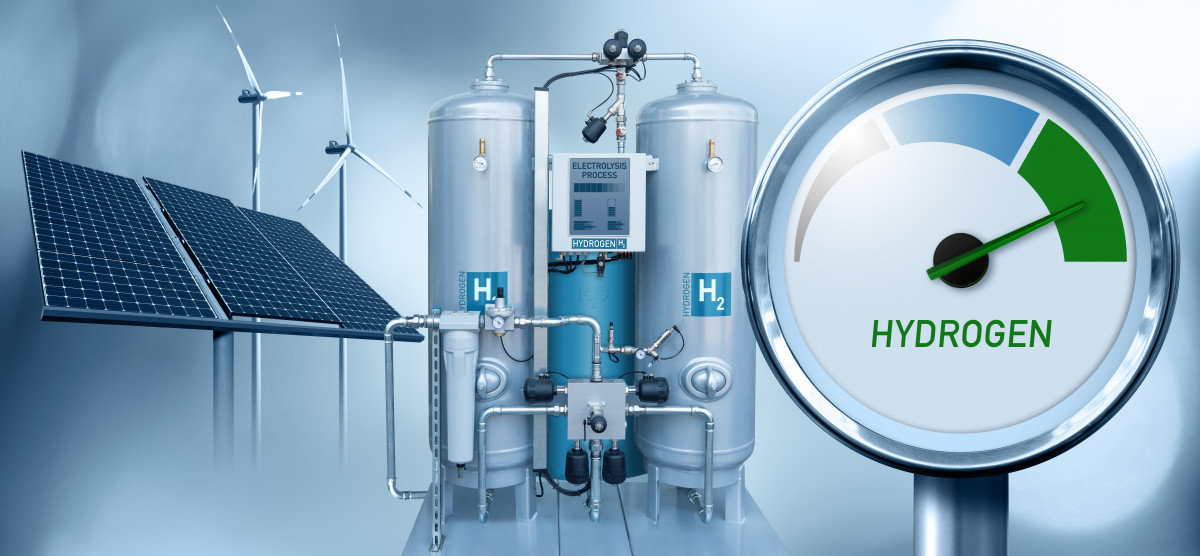
- 03 May 2024
Why is it in the News?
Developing a domestic manufacturing infrastructure for electrolyzers is expected to reduce the cost of green hydrogen and strengthen India's competitive advantage.
What are Electrolysers?
- Electrolysers are devices that produce hydrogen through a chemical process called electrolysis, which splits water molecules into hydrogen and oxygen molecules using electricity.
How do They work?
- These devices consist of a stack of conductive electrodes separated by a membrane, to which a high voltage and current are applied.
- This induces an electric current in the water, causing it to decompose into its constituents: hydrogen and oxygen.
- The generated oxygen is either released into the atmosphere or stored for future use as a medical or industrial gas.
- The hydrogen produced can be stored as a compressed gas liquefied for industrial use or utilised in hydrogen fuel cells, which power various transportation vehicles like trains, ships, and aircraft.
Types of Electrolysers:
- Alkaline Electrolysers: This technology, predominantly used by the fertiliser and chlorine industries, employs thick membranes and nickel-based electrodes.
- It currently represents a significant portion of global electrolyser capacity.
- Proton Exchange Membrane (PEM) Electrolysers: Operating at high pressure, PEM electrolysers utilise thin perfluorosulfonic acid (PFSA) membranes.
- Though they require gold and titanium-plated electrodes and catalysts like platinum, iridium, and ruthenium, they produce high-purity hydrogen and are easy to cool, making them a popular choice.
- Solid Oxide Electrolysis Cell (SOEC) Electrolysers: These devices utilise heat to produce hydrogen from steam and are ideal for locations with available heat sources such as nuclear or industrial facilities.
- Operating at high temperatures ranging from 500 to 850 degrees Celsius.
- Anion Exchange Membrane (AEM) Electrolysers: Operating at significantly lower temperatures of 50 to 60 degrees Celsius, AEM electrolysers combine the less harsh conditions of alkaline electrolysers with the simplicity and high efficiency of PEM electrolysers.
Electrolyzers and Green Hydrogen Production:
- Green hydrogen is renewable hydrogen produced using water electrolysis technology and electricity generated from renewable energy sources, such as solar or wind.
- It is gaining unprecedented momentum globally, and it is believed that it is a key component in accelerating the shift to clean energy.
- The commercialization of electrolyzers can make green hydrogen more readily available and enable energy systems across the globe to undergo fundamental transformations to lower emissions and reduce their negative impact on the environment.
Use of Green Hydrogen in the Transport Sector
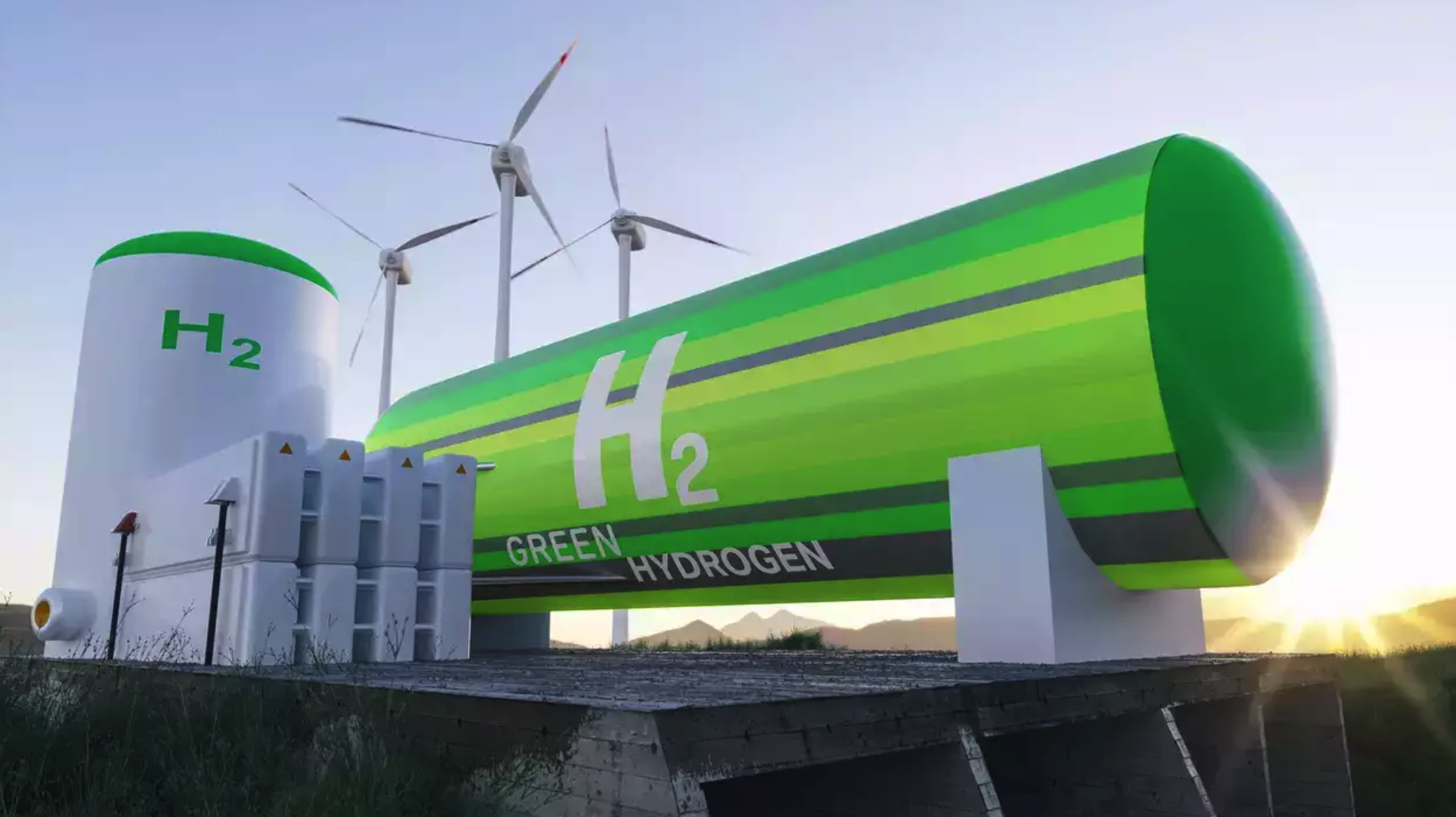
- 06 Apr 2024
Why is it in the News?
The Ministry of New and Renewable Energy (MNRE) has announced a Rs-496-crore (until 2025-26) scheme to support pilot projects that either test the viability of green hydrogen as a vehicle fuel or develop secure supporting infrastructure such as refueling stations.
What is Green Hydrogen?
- Green hydrogen is a form of hydrogen gas produced through a process called electrolysis, where water (H2O) is split into hydrogen (H2) and oxygen (O2) using electricity.
- The electricity used in this process is generated from renewable sources such as solar, wind, or hydroelectric power, hence the term "green" hydrogen.
- Unlike conventional methods of hydrogen production, which often rely on fossil fuels and emit greenhouse gases, green hydrogen production is considered environmentally friendly because it doesn't generate carbon dioxide emissions.
- It can be used as a clean energy carrier in various sectors, including transportation, industry, and energy storage.
- The production of green hydrogen is still relatively expensive compared to other forms of hydrogen production, but ongoing advancements in renewable energy technologies and electrolysis processes are expected to reduce costs and increase the viability of green hydrogen as a sustainable energy source in the future.
India's Push for Green Hydrogen in the Transportation Sector:
- India is aggressively pushing for the adoption of green hydrogen in its transportation sector:
- Major Indian commercial vehicle manufacturers like Tata Motors, Volvo Eicher, and Ashok Leyland are intensifying their efforts to develop hydrogen-powered trucks and buses.
- Simultaneously, Indian energy companies are ramping up efforts to increase the production of green hydrogen while striving to decrease costs, making it competitive with other fuels.
- Given its vast and expanding market for both vehicles and energy, India stands poised to reap substantial benefits from widespread green hydrogen adoption as a vehicular fuel.
- India anticipates numerous advantages from this transition, including mitigating pollution, achieving climate objectives, and reducing reliance on expensive fossil fuel imports.
- Moreover, India views this shift as a significant business opportunity, aiming to establish itself as a global hub for the production and export of green hydrogen.
Scheme for Use of Green Hydrogen in the Transport Sector:
- The Scheme for Use of Green Hydrogen in the Transport Sector focuses on several key objectives:
- Validating the technical feasibility and performance of green hydrogen as a transportation fuel.
- Evaluating the economic viability of vehicles powered by green hydrogen.
- Demonstrating the safe operation of hydrogen-powered vehicles and refueling stations.
- Under the scheme, the Ministry of Road Transport & Highways will designate a scheme implementation agency responsible for inviting proposals for pilot projects.
- Once selected, the chosen company or consortium will serve as the project's executing agency and must complete the pilot project within a two-year timeframe.
- To support these initiatives, the Ministry of New and Renewable Energy (MNRE) will consider approving viability gap funding (VGF) based on the recommendations of a Project Appraisal Committee.
- The VGF amount will be determined by assessing the specific needs, merits, and feasibility of each project.
Advantages of Green Hydrogen in the Transportation Sector:
- Hydrogen Internal Combustion Engine (ICE) vehicles utilize hydrogen through combustion, akin to traditional diesel and petrol vehicles, but without emitting carbon.
- Hydrogen Fuel Cell Electric Vehicles (FCEVs) convert hydrogen electrochemically into electricity, leaving water as the sole byproduct, offering a clean and efficient alternative.
- While hydrogen ICE vehicles emit no carbon, studies indicate that converting hydrogen into electricity in a fuel cell is more energy efficient than burning it.
- Unlike Battery Electric Vehicles (BEVs) where the battery is heavy, hydrogen FCEVs are typically lighter due to hydrogen being a lighter element.
- This lightweight characteristic of hydrogen fuel cell technology makes it particularly promising for heavy-duty trucks, providing a viable alternative to EV battery technology.
- Green hydrogen presents a significant opportunity to reduce carbon emissions in the transportation sector without compromising revenue-generating payload capacity, addressing both environmental and economic concerns.
Challenges to the Large-Scale Adoption of Green Hydrogen in the Transportation Sector:
- Cost Prohibitions: The production cost of green hydrogen remains high, posing challenges to its viability as a fuel option.
- To compete with Battery Electric Vehicles (BEVs), the cost of green hydrogen needs to be reduced to between $3 and $6.5 per kilogram by 2030.
- Retail green hydrogen prices in California reached as high as $30 per kilogram in 2023, underscoring the current cost disparity.
- However, ongoing technological innovations and scale-up efforts are expected to drive cost reductions soon.
- Insufficient Infrastructure: Building hydrogen fueling stations for trucks can cost up to 72% more than those for battery electric trucks, according to the California Transportation Commission.
- Challenges with supply complications and market factors have led to the closure of hydrogen refueling stations, exemplified by Shell's recent decision in California.
- Storage and Transportation Challenges: Hydrogen storage requires high-pressure cylinders, which are costly and pose technical challenges.
- Existing natural gas pipeline infrastructure is unsuitable for transporting hydrogen.
- Specialized cylinders capable of safely storing green hydrogen are under discussion, necessitating infrastructure development.
- Handling and Safety Concerns: Hydrogen's flammability necessitates stringent safety protocols and infrastructure at refueling stations.
- Developing robust safety standards is imperative before widespread adoption can occur.
- Long-Term Viability: Advancements in battery technologies are continuously improving the weight and efficiency of EV batteries, potentially challenging the long-term viability of green hydrogen-powered vehicles, particularly in heavy-duty commercial applications.
MNRE to discuss specialized cylinders for hydrogen storage with stakeholders
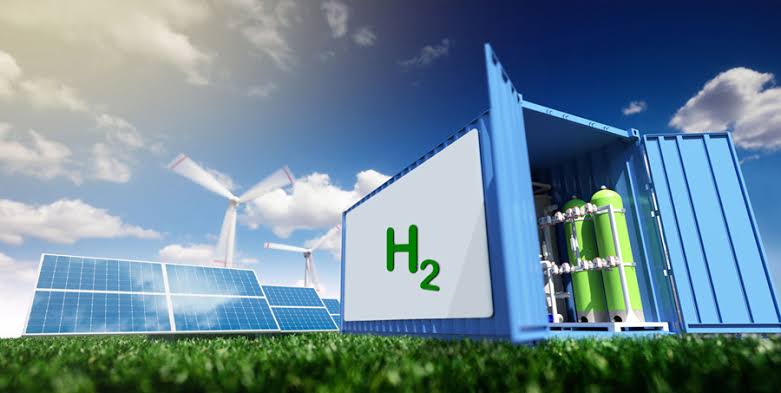
- 11 Mar 2024
Why is it in the News?
The Ministry of New and Renewable Energy (MNRE) plans to convene a meeting with relevant stakeholders to discuss the development of specialized cylinders for green hydrogen storage.
What is Green Hydrogen?
- Green Hydrogen is produced through the process of electrolysis of water, utilizing electricity generated from renewable energy sources.
- The carbon intensity of green hydrogen depends on the carbon neutrality of the electricity source, with higher renewable energy content resulting in greener hydrogen.
- With its potential to decarbonize various sectors, reduce carbon emissions, and achieve energy independence, green hydrogen holds significant promise.
- Its production from renewable sources like solar, wind, and hydropower makes it a sustainable and environmentally friendly alternative to traditional fossil fuels in transportation and industry, offering a consistent and reliable energy source.
- Storage: Hydrogen is stored in cylinders at high pressure, categorized into four types based on materials used. Type 1 and Type 2 are suited for storage, while Type 3 is ideal for storage and transportation, and Type 4 is recommended for on-board storage.
- Unlike compressed natural gas (CNG) stored at around 3,600 psi, hydrogen is stored at 5,000-10,000 psi.
- Vehicles can utilize hydrogen either by burning it in an internal combustion engine or by using a fuel cell to convert it into electricity to charge on-board batteries.
- Type 3 and Type 4 cylinders are reinforced with carbon fiber, making them lightweight and suitable for vehicles.
- Type 4 cylinders, lined with a polymer instead of aluminum like Type 3, are even lighter.
Application of Green Hydrogen:
- Green hydrogen finds diverse applications, including powering vehicles and generating electricity through fuel cells.
- It also serves in heating systems and the production of chemicals and fertilizers.
- Additionally, green hydrogen supports microgrids, facilitating electricity provision to remote areas and fostering energy independence.
Advantages and disadvantages of green hydrogen:
- 100 % sustainable: Green hydrogen does not emit polluting gasses either during combustion or during production.
- Storable: Hydrogen is easy to store, which allows it to be used subsequently for other purposes and at times other than immediately after its production.
- Versatile: Green hydrogen can be transformed into electricity or synthetic gas and used for commercial, industrial or mobility purposes.
However, green hydrogen also has negative aspects that should be borne in mind:
- High cost: Energy from renewable sources, which are key to generating green hydrogen through electrolysis, is more expensive to generate, which in turn makes hydrogen more expensive to obtain.
- High energy consumption: The production of hydrogen in general and green hydrogen in particular requires more energy than other fuels.
- Safety issues: Hydrogen is a highly volatile and flammable element and extensive safety measures are therefore required to prevent leakage and explosions.
PM Modi launches India’s first hydrogen-powered ferry built at Cochin Shipyard

- 01 Mar 2024
Why is it in the News?
Prime Minister Modi recently virtually launched India’s first indigenously developed hydrogen fuel cell ferry manufactured by Cochin Shipyard Limited (CSL), which will be deployed for service at Varanasi in Uttar Pradesh.
What is the "Harit Nauka" (Green Boat) Initiative?
- Initiated by the Ministry of Ports, Shipping, and Waterways, "Harit Nauka" aims to facilitate a sustainable transition of inland vessels.
- In January 2024, the shipping ministry introduced the "Harit Nauka" guidelines, outlining the path towards environmentally friendly practices for inland vessels.
- According to these guidelines, all states are mandated to progressively adopt green fuels for 50% of their inland waterway-based passenger fleets within the next decade, to achieve 100% adoption by 2045. This initiative aligns with the Maritime Amrit Kaal Vision 2047, aimed at reducing greenhouse gas emissions.
- The implementation of this initiative not only contributes to reducing emissions but also paves the way for replicating such environmentally friendly ferry models across the country to enhance urban mobility.
- Furthermore, it serves as a significant catalyst for advancing the objectives of the National Green Hydrogen Mission.
What are Hydrogen Fuel Cells?
- Hydrogen fuel cells harness the chemical energy of hydrogen to generate electricity, offering a clean energy solution with electricity, heat, and water as the sole products and by-products.
Functioning:
- Similar to batteries, fuel cells continuously produce electricity and heat as long as fuel is supplied. A typical fuel cell comprises two electrodes—an anode (negative electrode) and a cathode (positive electrode)—surrounding an electrolyte.
- Hydrogen fuel is supplied to the anode, while air is directed to the cathode. At the anode, a catalyst separates hydrogen molecules into protons and electrons, which then travel different paths.
- Electrons create an electric current through an external circuit, while protons migrate through the electrolyte to the cathode, combining with oxygen and electrons to form water and heat.
Challenges in India:
- High Cost: Fuel cell systems remain relatively expensive compared to conventional energy sources.
- Infrastructure Deficiency: India currently lacks the necessary infrastructure for the widespread adoption of fuel cell technology, including hydrogen production and distribution networks.
- Technical Hurdles: Despite ongoing advancements, fuel cell technology is still in its nascent stages, facing persistent technical challenges.
- Policy Constraints: The absence of a comprehensive policy framework from the Indian government has constrained the development and adoption of fuel cell technology, impeding research and investment.
India's Initiatives:
- In response to these challenges, India has formulated the National Green Hydrogen Policy, delineating a vision for the growth of the hydrogen and fuel cell industry.
- The policy aims to position India as a global hub for the production, utilization, and export of Green Hydrogen and its derivatives, signalling a strategic commitment to advancing sustainable energy solutions.
Characteristics of the Hydrogen-Powered Ferry:
- Length and Capacity: The hydrogen fuel cell vessel is a 24-meter-long catamaran, capable of accommodating up to 50 passengers in its air-conditioned passenger area.
- Battery-Free Operation: Distinguished by its innovative design, this ferry does not rely on conventional batteries for storing electrical energy.
- Instead, it utilizes hydrogen fuel, stored in cylinders onboard the vessel. With five hydrogen cylinders capable of carrying 40kg of hydrogen, the ferry can sustain operations for eight hours. Additionally, it features a 3-kW solar panel to complement its power source.
- Fuel Cell Technology: Equipped with a 50-kW PEM (proton-exchange membrane) fuel cell, coupled with Lithium-Ion Phosphate batteries, the ferry boasts adaptability in response to varying power demands.
- PEM fuel cells, renowned for their lower operating temperature, lightweight, and compactness, are commonly employed in automotive applications.
- Environmental Sustainability: With zero emissions and noise, coupled with enhanced energy efficiency, the hydrogen fuel cell-powered ferry stands as an environmentally friendly alternative.
- Its minimal moving parts contribute to reduced maintenance requirements compared to combustion vessels.
- Additional Advantages: While hydrogen fuel cell technology has been in development for maritime purposes, only a handful of countries worldwide have executed demonstration projects.
- Thus, this ferry positions India at the forefront, providing an early advantage in harnessing the potential of hydrogen as an emerging green fuel within the marine sector.
Oil Producers Water Down Provision on Fossil Fuel Phase-out (Indian Express)
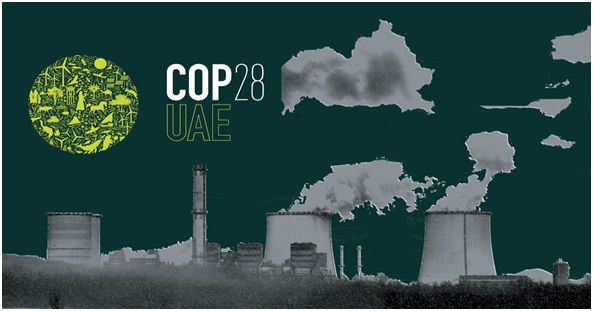
- 12 Dec 2023
Why is it in the News?
After four days of deadlock, a new draft agreement text emerged at the COP28 climate meeting that severely watered down earlier provisions on fossil fuel elimination but singled out coal for a rapid phase-down, which could be problematic for India.
Context:
- The 28th Conference of the Parties (COP 28) to the United Nations Framework Convention on Climate Change is underway in the United Arab Emirates from November 30 to December 12, 2023.
- During the climate meeting on December 10, negotiators took an initial step toward enhancing action on adapting to climate change.
- A draft text outlining potential "global goals" on adaptation was introduced for the first time, serving as a starting point for further negotiations.
- Negotiators are actively discussing various topics, including the contentious issue of fossil fuel phase-out, in informal sessions to find common ground.
- The draft document is titled 'Global Goal on Adaptation' (GGA) and aims to establish a shared global objective for adaptation, similar to the global goal of limiting temperature rise below the 1.5 degrees Celsius threshold for mitigation.
- This initiative addresses a longstanding demand from developing countries, emphasizing the need for increased focus and resource mobilisation for adaptation efforts.
- Notably, the draft removes the term 'phasing out' of fossil fuels but includes stronger language against coal, urging a "rapid phase-down of unabated coal," a point that may face objections from major consumers like India, Indonesia, and China, all developing countries heavily reliant on coal power.
Responses to the Draft Text 'Global Goal on Adaptation':
- The European Union (EU) and certain small island states promptly dismissed the draft agreement text.
- The EU climate commissioner criticized the overall insufficiency of the text, deeming it inadequate in addressing the climate change challenge.
- Primary dissatisfaction arose from the weakening of a provision related to the use of fossil fuels.
- The draft initially urged countries to "reduce both consumption and production of fossil fuels, in a just, orderly, and equitable manner."
- Notably, fossil fuels, responsible for nearly 80 percent of greenhouse gas emissions, have never been explicitly mentioned in prior COP decisions.
- While previous decisions emphasized the need to cut emissions, they avoided specifying actions for emission reduction.
- COP28 marked the first formal discussion of a fossil fuel phase-out but attempts to incorporate a robust provision faced resistance from oil-producing nations like Saudi Arabia and Russia.
- India, while not offering an immediate reaction to the draft agreement, has consistently asserted that singling out coal for accelerated reduction is discriminatory.
India's Ambitious Initiative to Expand Renewable Energy Capacity (Indian Express)
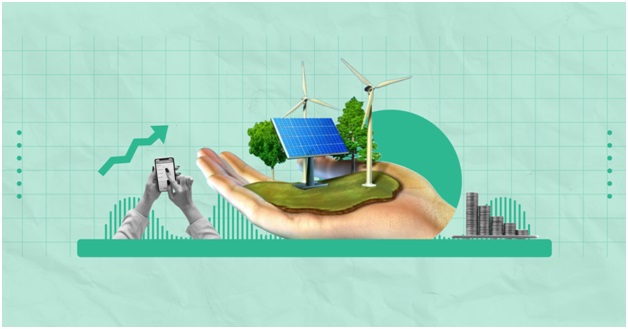
- 11 Dec 2023
Why is it in the News?
The Ministry of New and Renewable Energy (MNRE) has proposed an exemption for green hydrogen developers from adhering to its list of authorised manufacturers to enable them to import solar PV modules and wind turbine models from China.
What Does The Ministry of New and Renewable Energy (MNRE) Propose?
- The Ministry of New and Renewable Energy (MNRE) is exploring the option of granting an exemption to green hydrogen developers from its list of authorized manufacturers.
- This proposed exemption would enable these developers to import solar PV modules and wind turbine models from China, aiming to enhance the competitiveness of green hydrogen exports.
- It's noteworthy that Chinese manufacturers are presently absent from MNRE's Approved List of Models and Manufacturers (ALMM) and Revised List of Models and Manufacturers (RLLM).
The MNRE’s Proposal Background:
- After the 2020 Galwan Valley skirmishes, the Indian government issued directives to restrict the involvement of Chinese vendors in public procurement.
- Recently, the Indian procurement portal GeM announced the removal of hundreds of Chinese vendors over the past three years.
- At a time when energy companies are intensifying efforts to mass-produce green hydrogen, essential for which are renewable energy equipment and electrolysers, the government has sidelined Chinese manufacturers.
- This aligns with the MNRE's policy to enhance domestic manufacturing of renewable energy equipment.
- While central PSUs may face restrictions on importing electrolysis machinery from China, others continue to do so.
- In FY23, India witnessed a 40% increase, in importing machines and apparatus for electroplating, electrolysis, and electrophoresis, worth $45.61 million, compared to the preceding fiscal year.
What is the Significance of the MNRE’s Proposal?
- ??The proposal to import solar PV modules from China carries significance in bolstering the supply chain and enhancing the global competitiveness of Indian green hydrogen exports.
- Central PSUs such as Indian Oil Corporation Ltd and NTPC Ltd, both actively involved in green hydrogen projects, would benefit by sourcing equipment from Chinese manufacturers.
- This move is poised to strengthen India's position in the global green hydrogen market, aligning with the objectives outlined in the National Green Hydrogen Mission and facilitating the achievement of set targets.
Scientists find hydrogen cyanide, a key molecule for life formation, in Saturn’s icy moon Enceladus (Sci News)
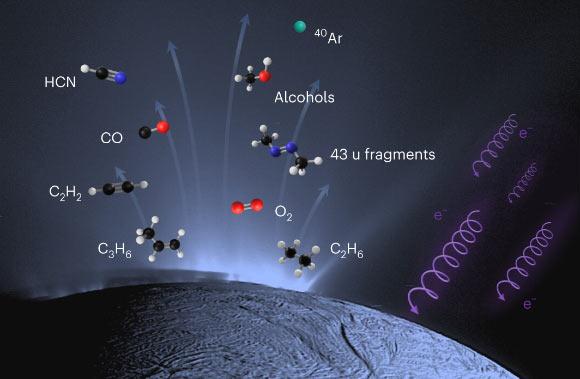
- 18 Dec 2023
Why is it in the News?
Recently, planetary scientists have detected several compounds of strong importance to the habitability of Saturn’s icy moon Enceladus, including hydrogen cyanide, acetylene, propylene and ethane, using data from NASA’s Cassini mission.
What is Enceladus?
- Enceladus is the sixth-largest icy moon of Saturn. It has a white, streaky surface made of water ice.
- Beneath this frozen crust lies a warmer, salty ocean that covers the whole moon.
- This circular moon is just about 500 km wide, with a surface temperature of -200°C.
- But its interiors host several sources of energy and heat.
- Enceladus is tugged and pulled in all directions by Saturn’s gravity and the gravity of other more massive moons, thus creating heat in its interior.
- Its rocky core may also be undergoing radioactive decay and chemical reactions that generate heat.
- Moreover, it is also an active source of water volcanism, where giant plumes of water, ice, dust, and gases are ejected into space like volcanic explosions.
- The material from the plumes replenishes one of the rings of Saturn as well, as the icy particles that make up the rings slowly drift inwards and get pulled into Saturn.
- The presence of a global saltwater ocean with nutrients and a heat source suggests a suitable aquatic environment for life.
- However, no life has been found on Enceladus or anywhere else beyond Earth.
About Hydrogen cyanide:
- Hydrogen cyanide is a chemical compound with the formula HCN and structural formula H−C≡N.
- It presents itself as a colourless or pale-blue liquid or gas, characterized by a bitter, almond-like fragrance.
- Alternatively referred to as hydrocyanic acid or HCN, this substance has the potential to disrupt the body's oxygen utilization, posing risks to the brain, heart, blood vessels, and lungs.
- While Hydrogen cyanide boasts excellent solvent properties for numerous salts, its utilization as a solvent is limited due to its inherent toxicity.
- In various industrial settings, it finds application in tasks such as fumigation, electroplating, mining, chemical synthesis, and the manufacturing of synthetic fibres, plastics, dyes, and pesticides.
